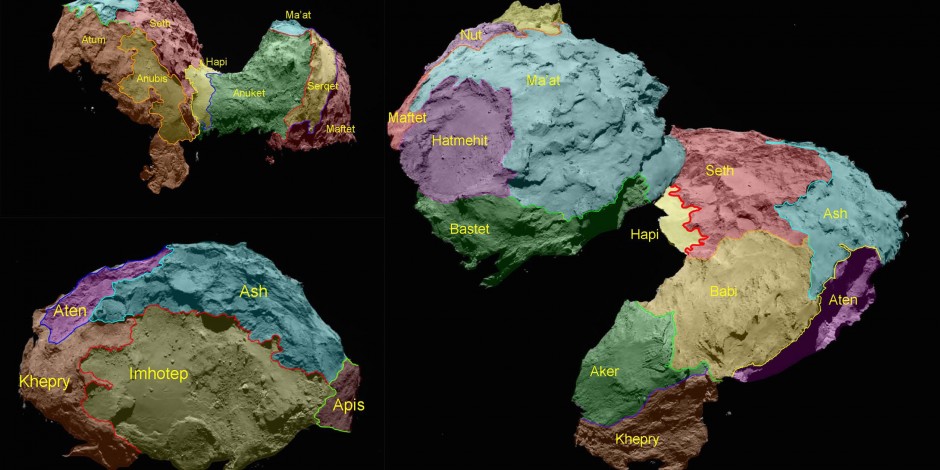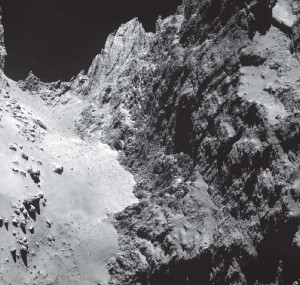Intriguing features on Chury’s surface

A group of researchers led by scientists at the University of Bern have recently published a study describing many amazing and intriguing features on the surface of a comet using new images from the European Rosetta space mission.
Various viewing angles for 67P/Churyumov-Gerasimenko with overlain colorized regions. The regions have been named using ancient Egyptian gods and goddesses in accordance with the ancient Egyptian naming theme agreed for the mission. (Credit: Sciencemag.org)
The Rosetta spacecraft was inserted into orbit around comet 67P/Churyumov-Gerasimenko on Aug 6, 2014. Since then, the comet’s nucleus has been extensively imaged and monitored by the Optical, Spectroscopic, and Infrared Remote Imaging System (OSIRIS) at amazing resolutions that allow scientists to study the surface of the comet in detail for the first time and identify features on the surface that are smaller than 1 metre in size. Furthermore, the mission was also successful in landing a small spacecraft (named Philae) on a comet for the first time in the history of space exploration.
Comet 67P/Churyumov-Gerasimenko has a very irregular shape as it consists of a large lobe, which scientists like to call the “body”, connected to a smaller lobe, or a “head” by a narrow “neck” region. OSIRIS images show landscapes, which at first sight, look familiar to typical alpine landscapes we see here in Switzerland. We can see steep cliffs, large “rocks”, and structures that look like “avalanches”. This familiar setting is mis-leading because comets have such low densities, even less than that of water, that rocks as we know them on Earth cannot exist on the surface of the comet.
In a paper recently published in the international journal “Science”, researchers led by PlanetS members Nicolas Thomas and Ramy Mohamed Elmaarry at the University of Berne describe the amazing features that have been observed on the surface of the comet, which include highlights such as steep cliffs, large depressions, small pits that appear to show materials flowing out of them similar to volcanoes, and even smooth-looking terrains, which show features similar to sand dunes!
View of the “neck” region between the two lobes showing steep cliffs, smooth terrains and scattered boulders. In this area the cliff rises above the smooth terrain by almost 900 meters. (Credit: ESA/Rosetta/MPS for OSIRIS Team MPS/UPD/LAM/IAA/SSO/INTA/UPM/DASP/IDA)
Rosetta is expected to continue monitoring the surface of the comet as it orbits closer to the sun and becomes more active, which will allow the scientists to observe in detail for the first time how a comet behaves as it approaches the Sun, and how the surface may change due to this activity. (lg)
The details of the study are publically available online from the Science magazine website (http://www.sciencemag.org/content/347/6220/aaa0440.full).
Categories: External Newsletter


